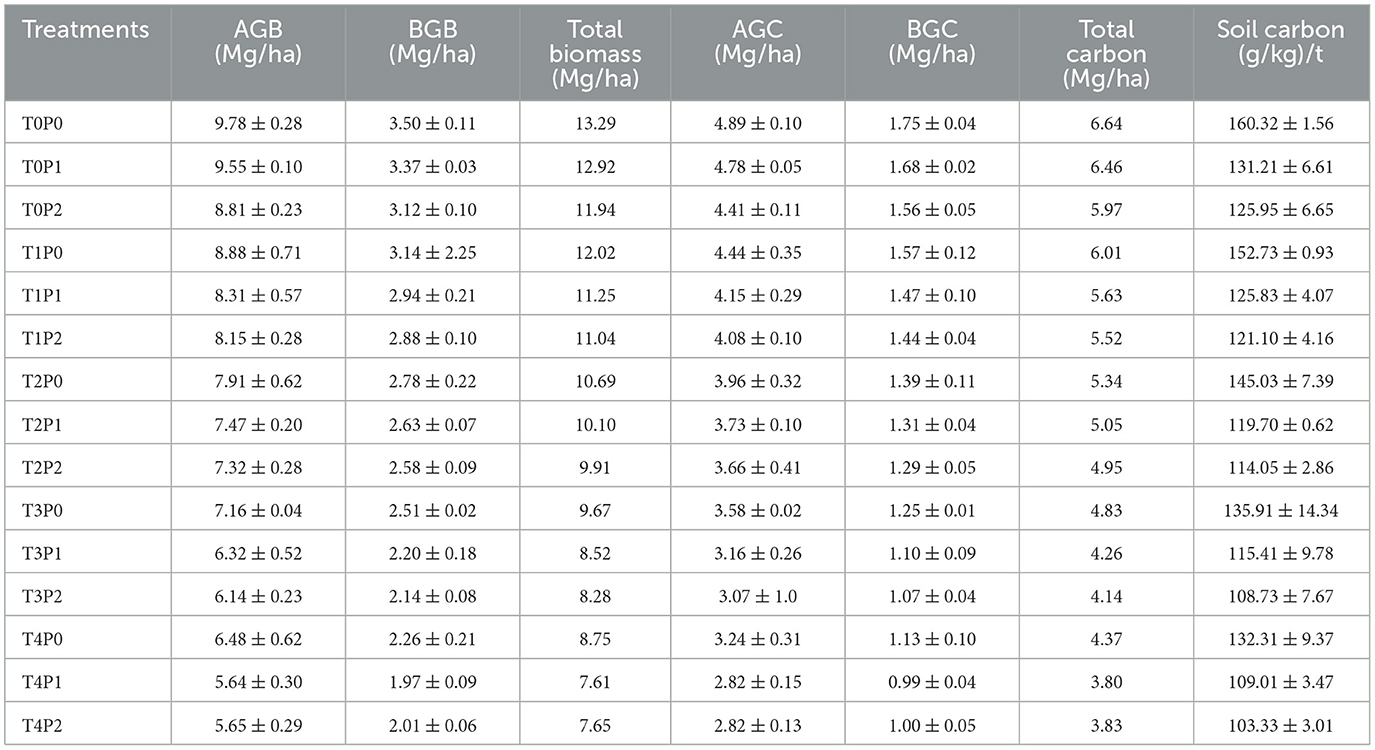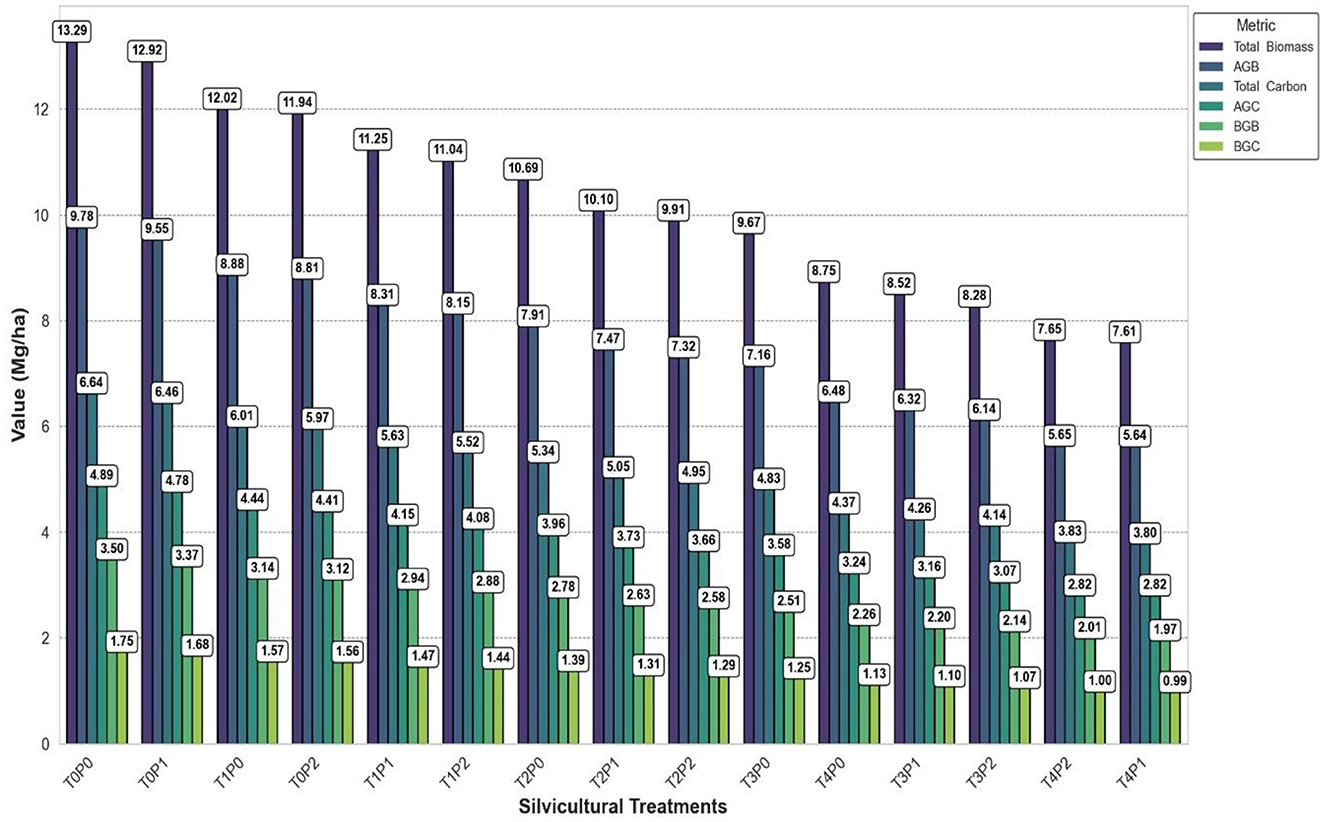- 1State Key Laboratory of Efficient Production of Forest Resources, Engineering Technology Research Center of Pinus Tabuliformis of National Forestry and Grassland Administration, Beijing Forestry University, Beijing, China
- 2Key Laboratory for Silviculture and Conservation of the Ministry of Education, Beijing Forestry University, Beijing, China
- 3School of Geophysics and Geomatics, China University of Geosciences, Wuhan, China
- 4State Forestry and Grassland Administration Key Laboratory of Forest Resources and Environmental Management, Beijing Forestry University, Beijing, China
- 5Mapping and 3S Technology Center, Beijing Forestry University, Beijing, China
Forestry management practices, such as thinning and pruning, significantly influence biomass accumulation and carbon sequestration, which are critical for climate change mitigation. This study examines the impact of thinning and pruning intensities on biomass and carbon stocks in 50-year-old Larix principis-rupprechtii Mayr plantations at Saihanba Mechanical Forest Farm in Northern China. The research involved 45 plots subjected to 15 treatments, each with 3 replicates. The Comprehensive assessments were made for aboveground biomass (AGB), belowground biomass (BGB), and total biomass. The statistical significance of differences between treatment groups was assessed using Analysis of Variance (ANOVA) and Regression analysis. The results demonstrated significant reductions in AGB, BGB, and total biomass with increased thinning intensity, up to 42.9% for AGB and 42.6% for BGB compared to the control treatment. The percentage decrease in total biomass from the control treatment, T0P0, to the most intensive treatment, T4P2, is approximately 42.5%. The percentage decrease in total carbon over the control treatments is about 42.7%. The soil organic carbon (SOC) decreased by 35.6% compared to the control treatment. Pruning influences tree structure and health. The findings highlight the complex interactions between forest management practices and carbon dynamics, emphasizing the adoption of light to moderate thinning and pruning strategies. These approaches can sustain the forest's carbon sequestration capabilities while maintaining forest health and productivity. This study provides empirical evidence to guide future forest management decisions, emphasizing the critical balance needed to maximize forest health and carbon sequestration potential.
1 Introduction
The rapid increase in greenhouse gas emissions, particularly carbon dioxide (CO2), is widely recognized as the primary cause of global warming (Barzagli and Mani, 2019; Bhatti et al., 2024). The importance of addressing this issue is evidenced by international agreements such as the Kyoto Protocol and the Paris Agreement, which emphasize the need to reduce atmospheric CO2 levels (Ussiri and Lal, 2017; Nunes et al., 2020). One of the most effective natural methods for carbon sequestration is photosynthesis, where trees absorb and store carbon. Forests play a critical role as carbon sinks within the carbon cycles of terrestrial ecosystems (Sha et al., 2022).
The Kyoto Protocol has addressed the potential of forests in reducing climate change through Articles 3.3 and 3.4, where forest carbon storage, particularly through afforestation and reforestation, is a significant factor in carbon reduction at the local, regional, national, and global levels (Dar et al., 2020). In 2015, the Paris Agreement established the long-term temperature goals to limit the global average warming to 2°C and try to keep it below 1.5°C by the end of the twenty-first century (Huang and Zhai, 2021). China contributed 26% of global greenhouse gas emissions (Zheng et al., 2019). The Chinese government, as the first developing country to submit the Nationally Determined Contributions (NDCs), committed to reaching the peak of CO2 emissions before 2030 and to making efforts to achieve carbon neutrality before 2060 in September 2020 (Sun et al., 2022).
Thinning can also influence forest carbon dynamics by affecting tree respiration and biomass loss (Fekadu Hailu et al., 2021). By expanding the canopy and thereby optimizing light distribution (Gonçalves, 2021; Dobner et al., 2019). Thinning creates spaces between crowns, which frequently fill up, further benefiting forest structure, Despite the known benefits of thinning in forest management their specific impacts on carbon sequestration and biomass in forests (Wang et al., 2024a; Ganatsas et al., 2024).
Pruning, another crucial forest management technique, primarily aims to enhance timber quality by producing logs free of knots (Matsushita et al., 2022; Lu et al., 2018). It also plays a significant role in improving light availability within the canopy, and cone formation in larch orchards correlates well with increased light intensity (Li et al., 2021) Pruning can impact growth in height and diameter, but these effects are generally limited and temporary (Lewark, 2022; Dufour, 2019). Low-intensity pruning can improve light usage efficiency and increase photosynthetic rates in the upper canopy by removing the less efficient, lower regions of the crown (Forrester et al., 2013).
Forests play a crucial role in the global carbon cycle, serving as significant carbon sinks when preserved and as sources of carbon when burned (Joshi and Singh, 2020; Mehmood et al., 2025). Increasing forest cover is vital for enhancing carbon sequestration and combating global warming, particularly in areas with low forest density and growing populations (Kay et al., 2019; Zhang et al., 2023). Accurate assessment of forest carbon sources and sinks is essential for the development of the global carbon market (Olivier and Berdowski, 2021; Ke et al., 2023). Despite the known role of trees as carbon sinks, estimating their carbon sequestration potential involves considerable uncertainty, largely due to challenges in converting field data into reliable biomass estimates (Khan et al., 2020). Biomass equations, which utilize allometric relationships between tree dimensions, are essential to this process (Daba and Soromessa, 2019). Factors such as biomass distribution among aboveground and belowground components, tissue carbon content, and stand basal area significantly influence total forest carbon (Siddiq et al., 2021).
Greenhouse gas (GHG) emissions and other harmful gases are among the most prominent world issues due to their climate change impacts (Murphy, 2024; Singh, 2021). Previous research has shown that other carbon sources, such as biomass, are more suitable, which could reduce these concerns (Salehi et al., 2022). Forest biomass is generally categorized into fuelwood and industrial roundwood (Perea-Moreno et al., 2019). Fuelwood is harvested from forestlands and is burnt directly to produce heat or is converted into bioenergy and biofuel to produce heat and power. This burning of fuel wood makes the carbon free, which is locked in the biomass, thereby contributing GHGs to the atmosphere (Caurla et al., 2018).
In northern China, warm temperate subalpine regions are ideal for growing larch Larix principis-rupprechtii Mayr, a species well-suited to afforestation due to its strong environmental adaptation and valuable wood quality. These larch forests are critical carbon sinks with significant social, economic, and ecological benefits (Giweta, 2020; Krueger et al., 2017). Accurate biomass estimates for Larix principis-rupprechtii Mayr are crucial for evaluating their carbon sequestration potential and supporting China's goal of carbon neutrality (Yuan et al., 2023; Hao et al., 2024).
Although thinning and pruning have been extensively studied as individual treatments, their combined effects on biomass partitioning and carbon storage remain poorly understood, particularly in mature larch plantations in northern China's high-altitude temperate regions. The intensity of silvicultural interventions plays a critical role in shaping forest carbon dynamics. For instance, heavy thinning reduces stand density and leaf area index, leading to immediate declines in aboveground biomass and soil carbon due to reduced litter input and increased exposure to soil surfaces (Zhang et al., 2018; Long et al., 2004). Although residual trees may experience compensatory growth, their contribution to carbon stocks often does not offset the initial loss over short- to medium-term periods (Teron et al., 2024; Li et al., 2024a). Similarly, intensive pruning decreases canopy volume and photosynthetically active area, temporarily limiting carbon assimilation and delaying biomass recovery (Suchocka et al., 2021). These ecological dynamics form the basis of our hypothesis that increasing the intensity of thinning and pruning will lead to measurable reductions in total biomass and carbon stocks.
Previous research shows considerable response variability depending on species, stand age, and management intensity. However, few empirical studies have systematically assessed above-ground and below-ground carbon dynamics under varying intensities of thinning and pruning. Therefore, this study addresses the following questions: (1) How do different thinning and pruning intensities affect biomass accumulation and carbon stock in mature Larix principis-rupprechtii Mayr plantations? (2) What are the interactive effects of thinning and pruning on stand structure, tree-level growth, and soil organic carbon? (3) Which management intensities optimize carbon sequestration while maintaining forest productivity? This research seeks to fill a critical knowledge gap by providing quantitative insights that can inform climate-responsive silvicultural planning in larch ecosystems.
2 Materials and methods
2.1 Location and description of the study area
The study area included the Saihanba Forest Farm, which is located in Hebei Province and ranges between (41°22′-42°58′ N, 116°53′-118°3′ W). The research site is in the warm temperate continental monsoon climate zone. The altitude of the area is 1,010–1,940 m. The mean annual temperature is −1.2°C, and the average annual temperature ranges from −43.3°C to 33.4°C. The annual rainfall is 452.2 mm, and the annual evaporation is 1,388 mm (Ali et al., 2025).
The common soil types in the region include aeolian sandy soil, meadow soil, brown soil, and gray forest soil. The total operating area is 94,000 hectares, of which the forest area is 73,333 hectares, planted forest 57,333 hectares, and natural forest 16,000 hectares; the forest coverage rate is 80%, total forest volume is 5.025 million m3. The most important vegetation zones include grassland, meadow, conifer and broad-leaved mixed forest, broad-leaved forest, and shrub forest; the forest density is 75.5%. The main trees are Larix principis-rupprechtii, Picea asperata Mast., and Betula platyphylla Suk., and the main shrubs are Rhododendron micranthum Turcz., Syringa oblata Lindl. var. alba Rehder., and Sambucus williamsii Hance. The main herbaceous plants are Galium verum L. and Menyanthes trifoliata L (Tao et al., 2023; Xu et al., 2022; Figure 1).
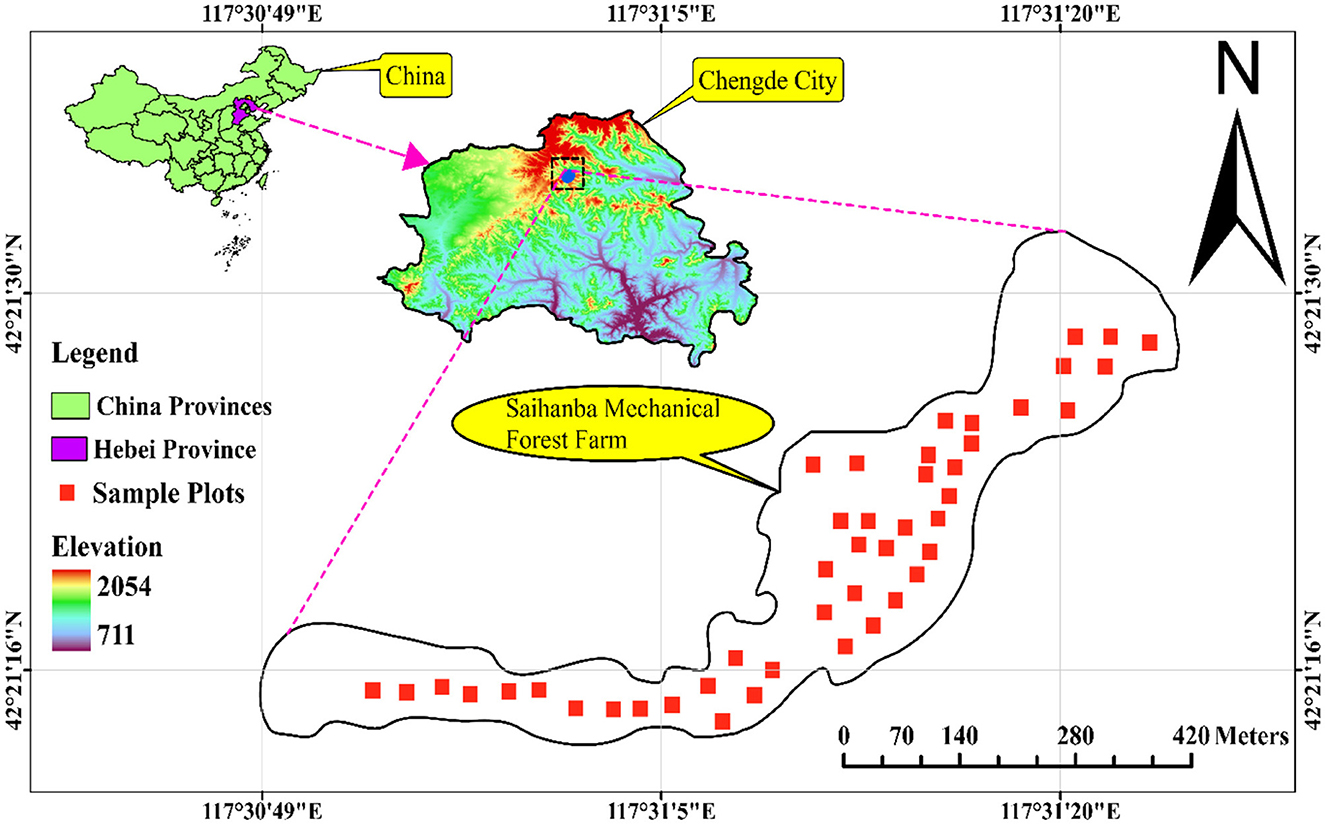
Figure 1. Location of the study sites in China, Chengde City, Hebei Province, Saihanba Mechanical Forest Farm.
2.2 Field sampling
The Larix principis-rupprechtii Mayr plantation was utilized for a silvicultural experiment involving thinning and pruning operations. The thinning and Pruning operation was done in June 2010. Initially, selective thinning was conducted before establishing the trial, focusing on removing smaller or deformed stems. The plantation was then subjected to various treatments, including five levels of thinning intensity (T0—control thinning at 0%, T1—light thinning at 10%, T2—moderate thinning at 20%, T3—heavy thinning at 30%, T4—extreme heavy thinning at 35%) and three levels of pruning intensity (P0—control pruning at 1:2, P1—light pruning at 1:3, P2—high pruning at 2:3). The objective of the thinning operation was to selectively reduce the number of stems per hectare according to the intensity level. Simultaneously, the pruning operation aimed to remove the middle crown branches of the trees, based on the specified intensity level. In August 2023, a comprehensive site survey led to the establishment of 45 sample plots, each with a plot size of 20 m × 20 m. At this time, the forest was 50 years old. The plantation was evaluated across these 45 plots, with 15 distinct silvicultural treatments, each consisting of 3 replicates (Figure 2).
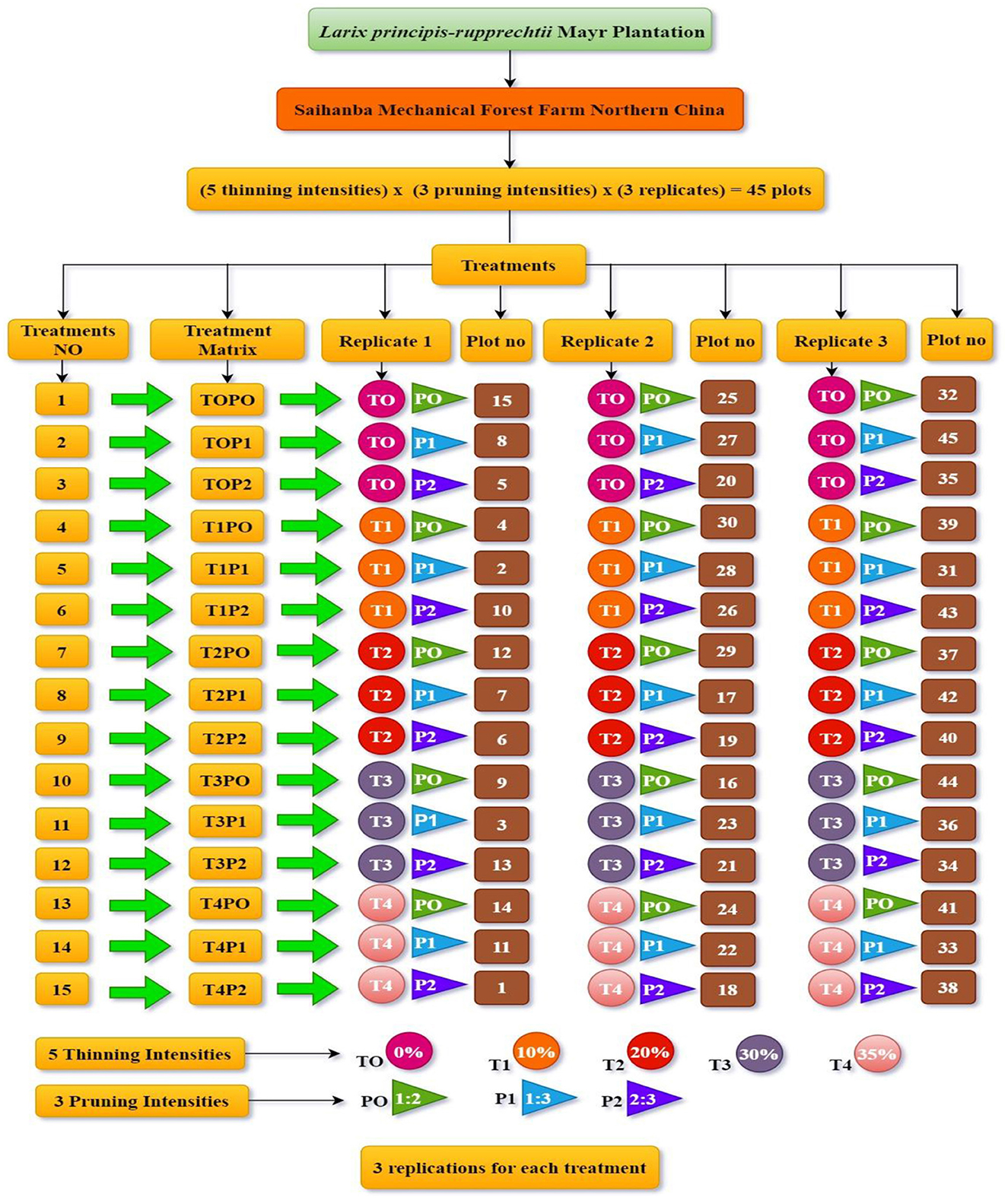
Figure 2. The methodological layout of the sampling plots in Stands of 50-Year-Age of Larix principis-rupprechtii Mayr plantation. The thinning operation was intended to reduce the number of stems/ha by selective thinning (depending upon intensity level). In contrast, the pruning operation was designed to lower the middle crown branches of the individual tree (depending upon the intensity level).
2.3 Data collection
The coordinates of each tree and plot were recorded using Real-Time Kinematic (RTK) technology. For analysis, we recorded the elevation, aspect, and slope of each plot, as well as the height (meters), stem density (trees per hectare), and the diameter at breast height (DBH), measured at 1.3 meters above the ground using a calibrated Diameter tape and Caliper. Stem density was determined by counting the number of trees within each plot. Tree heights were measured using a Relascope (Ali et al., 2023). Soil samples were collected from the upper 20 cm layer using a soil auger to determine soil organic carbon (SOC; Pathak and Reddy, 2021). These samples were placed in plastic bags, air-dried, and then sent to a laboratory for further analysis. This study's systematic procedure was designed to quantify key forestry metrics necessary for understanding carbon dynamics and the structural stability of the forest ecosystem.
We applied allometric equations for the various tree components to estimate the total biomass distribution, including stems, branches, leaves, and roots. These equations were developed based on destructive sampling and measurements of Larix principis-rupprechtii Mayr in the Saihanba Mechanical Forest Farm, Northern China. The predictor variables in these equations include DBH and tree height, key factors influencing biomass distribution. These allometric models have been validated for the species of interest and allow for precise calculations of above-ground and below-ground biomass (Supplementary Table S1; Zhao et al., 2016). To estimate the above-ground carbon (AGC) and below-ground carbon (BGC) amount, the obtained aboveground and belowground biomass values were multiplied by 0.5, assuming that the total amount of aboveground and belowground biomass had a 50% carbon content (Aye et al., 2022; Eshetu and Hailu, 2020). The amount of organic carbon in the soil was determined by applying an external heating and oxidation technique with potassium dichromate-concentrated sulfuric acid (Li et al., 2024b).
2.4 Statistical analysis
Descriptive statistics (mean and standard deviation) were computed for forest structural and carbon variables across silvicultural treatments. A two-way Analysis of Variance (ANOVA) within a general linear model (GLM) framework was applied to assess the individual and interactive effects of thinning and pruning on key response variables, including DBH, tree height, basal area, volume, stem density, and carbon pools (Feng et al., 2025; Equation 1).
This equation enables testing of both main effects and potential interaction effects, thereby capturing any non-additive influences of combined silvicultural treatments on forest dynamics.
Before conducting ANOVA, diagnostic checks were performed to ensure the model's assumptions were met. The normality of residuals was assessed using the Shapiro-Wilk test and verified through Q-Q plots (Ganesh and Pragasan, 2024; He et al., 2025). Homogeneity of variance (homoscedasticity) across treatment groups was tested using Levene's test. These tests confirmed that the key assumptions were satisfied. Where mild deviations were detected, log transformations were evaluated but were ultimately not applied, as the original data scale yielded statistically robust and interpretable results within the ANOVA framework.
The use of two-way ANOVA is particularly justified in this study due to the balanced factorial design with replication (n = 3 for each of the 15 treatment combinations), which meets the assumptions of normality and homoscedasticity required for ANOVA. Statistical significance was assessed using F-tests, and post-hoc comparisons were performed using Tukey's Honestly Significant Difference (HSD) tests, allowing us to compare treatment means pairwisely. Tukey's HSD was selected because it robustly controls the family-wise error rate, ensuring statistical validity when conducting multiple comparisons. Given the large number of treatment combinations, this test was particularly suitable to minimize the risk of Type I error while maintaining the interpretability of differences among treatment groups. We reported F-values, corresponding P-values, and R-squared (R2) values to quantify the strength and proportion of variance explained by each treatment factor (Singh and Kumar, 2022).
Regression analyses were also conducted where relevant to investigate continuous relationships between biometric parameters and topographic variables. All analyses were conducted using R version 4.3.2 (Braun and Murdoch, 2021).
The ggplot2 package generated detailed visualizations. Data wrangling and preparation were handled using dplyr. For inferential statistics, multcomp and multcompView facilitated multiple comparisons and visualization of statistical groupings. Plot arrangements were managed using gridExtra and cowplot, while grid enabled fine-tuning of graphical elements. These tools ensured a high degree of reproducibility and clarity in both statistical outputs and figure presentations (Lai et al., 2023). Relationships between topographic variables (elevation, slope, and aspect) and tree biometric parameters were assessed using simple linear regression analysis. Each model reported the R2, F-statistic, and P-value to evaluate the strength and significance of the associations. Principal Component Analysis (PCA) was also applied to reduce the dataset's dimensionality and identify significant variation gradients in forest structure, biomass, and carbon stock parameters (Sharma and Kakchapati, 2018; Kaushal and Baishya, 2021). The PCA was conducted on standardized data using the prcomp function in R. Variable contributions to the principal components were examined, and biplots were generated to visualize treatment groupings and the relationships among variables. The selection of principal components was based on eigenvalues >1 and cumulative variance exceeding 90% (de Oliveira et al., 2021).
3 Results
3.1 Treatment-wise stand metrics
The highest DBH values were observed in the most intensely thinned treatments, T3P2 and T4P2, compared to the control treatment, T0P0. Similarly, tree height increased with thinning intensity, with the tallest trees recorded in the T3P2 Treatment. The basal area and volume decreased as thinning intensity increased. The control treatment exhibited the highest basal area and volume. The control treatment also had the highest stem density, while the most heavily thinned treatment, T4P2, showed the lowest density (Table 1).
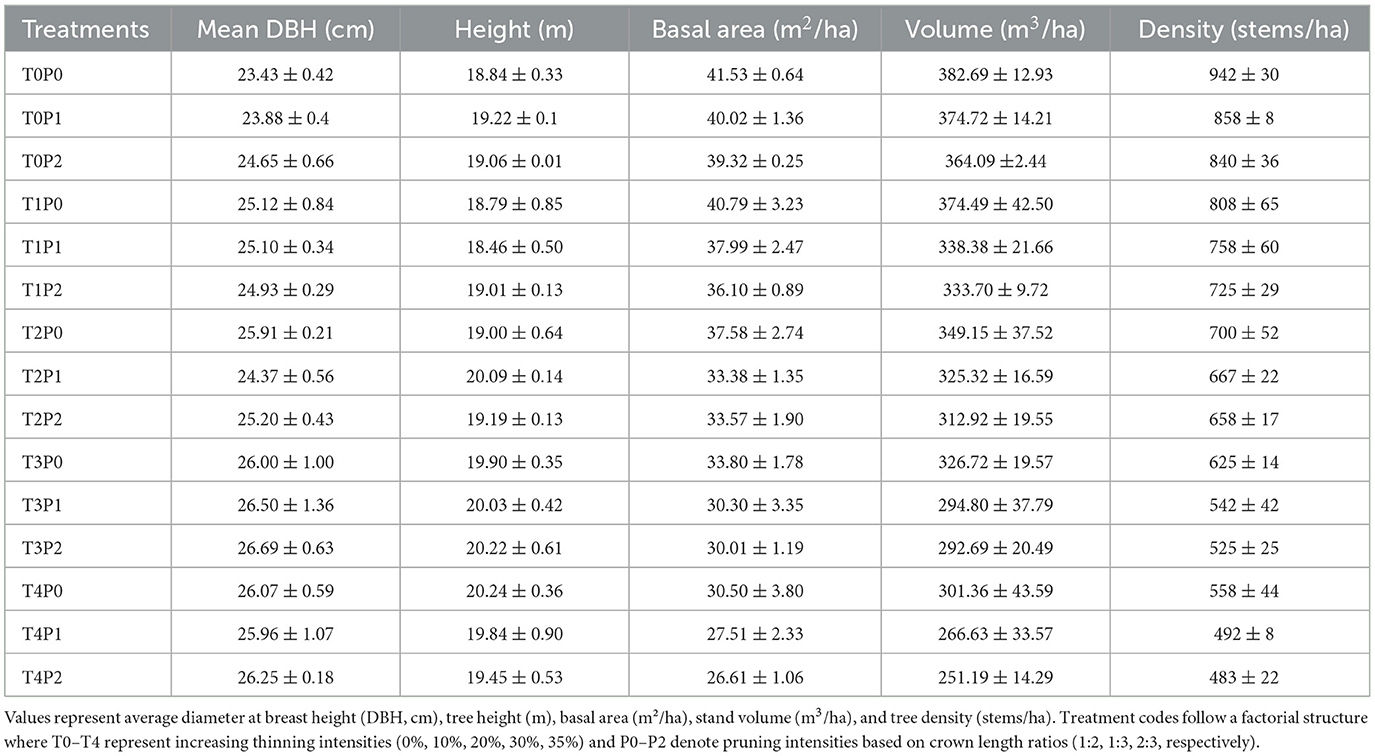
Table 1. Mean ± standard error (SE) of stand structural attributes under different thinning and pruning treatment combinations (n = 3 replicates per treatment).
3.2 Treatment-wise analysis of total biomass and total carbon
The control treatment (T0P0) exhibited the highest values for AGB and BGB, while the most heavily thinned and pruned treatments, T4P1 and T4P2, demonstrated the lowest values for these parameters. The total biomass, the sum of AGB and BGB, was highest in T0P0 and lowest in T4P1. Regarding carbon content, T0P0 also showed the highest values for AGC and BGC, whereas these values significantly decreased in T4P2 treatment. The soil carbon content was highest in the control treatment and progressively lower in the more heavily thinned and pruned treatments, such as T4P1 and T4P2 (Table 2; Figure 3).
3.3 ANOVA comparison of thinning and pruning effects on stand metrics
The Analysis revealed that thinning significantly influenced the mean DBH, whereas pruning had no significant effect. Tree height was also significantly affected by thinning but not by pruning. Both thinning and pruning had significant impacts on basal area and Volume, with thinning causing a greater reduction in volume, particularly in the most heavily thinned treatments. Pruning likewise reduced volume, though to a lesser extent. Tree density was significantly decreased by thinning, with pruning also having a significant effect. The effects of the thinning and pruning interactions were further tested across all structural and carbon-related variables. Notably, a statistically significant interaction was found only for soil carbon, while all other variables showed non-significant interactions (Supplementary Table S2; Table 3; Figures 4–6).
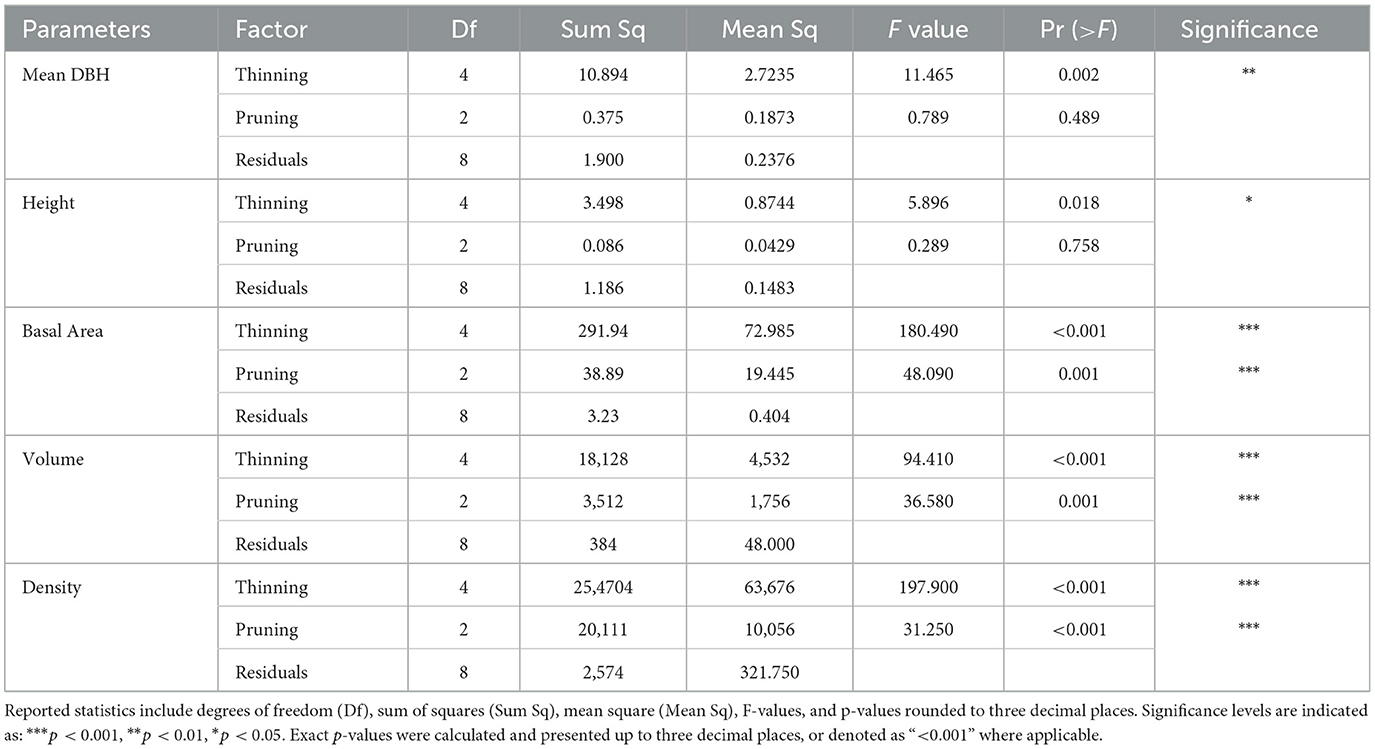
Table 3. Two-way ANOVA results showing the effects of thinning and pruning on stand structural metrics.
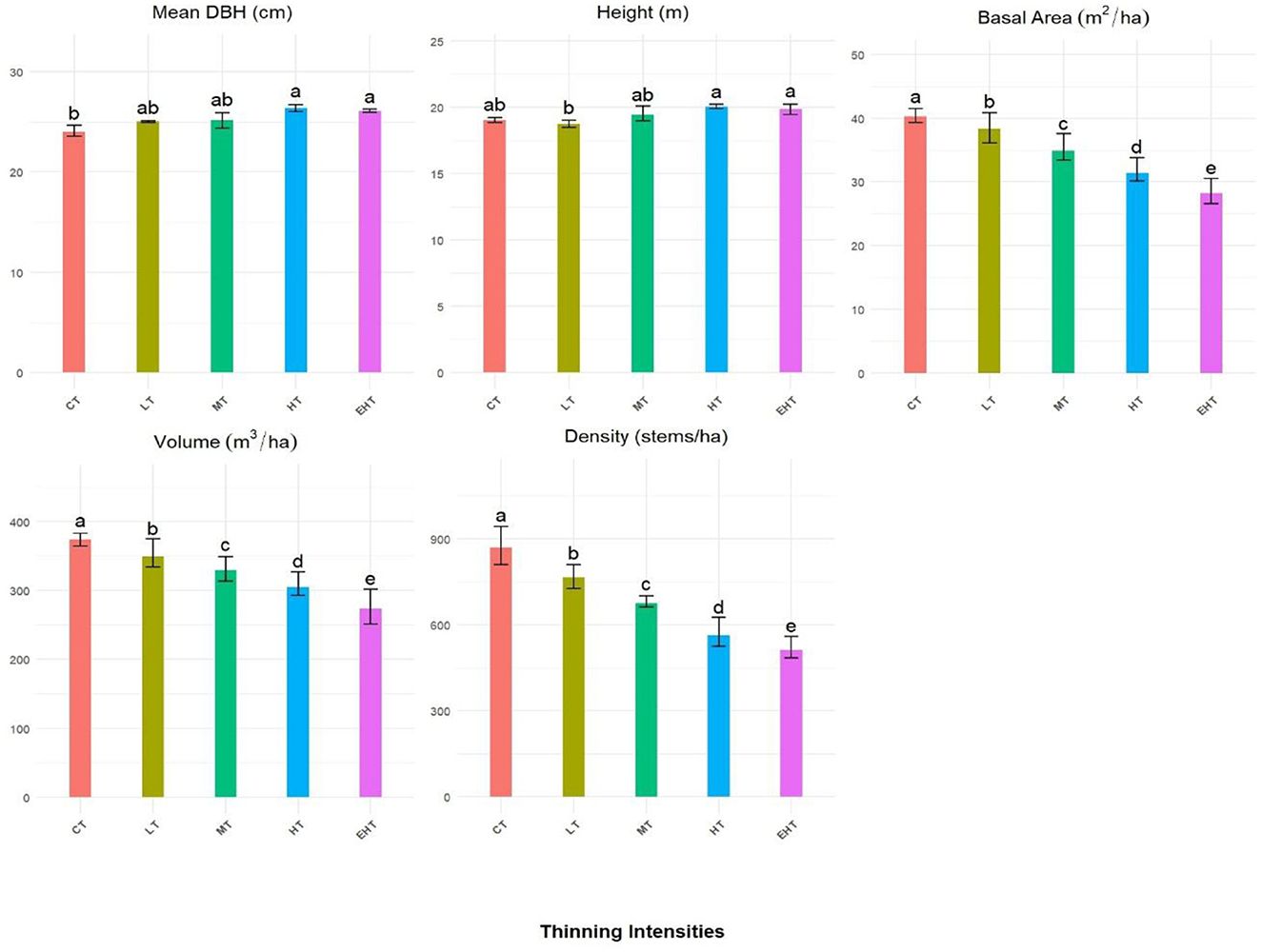
Figure 4. Stand characteristics of thinning intensities in Stands of 50-Year-Age of Larix principis-rupprechtii Mayr plantation. Different letters over bars are significantly different by Tukey HSD post-hoc test (p = 0.05; CT, control thinning; LT, light thinning; MT, moderate thinning; HT, heavy thinning; EHT, extreme heavy thinning).
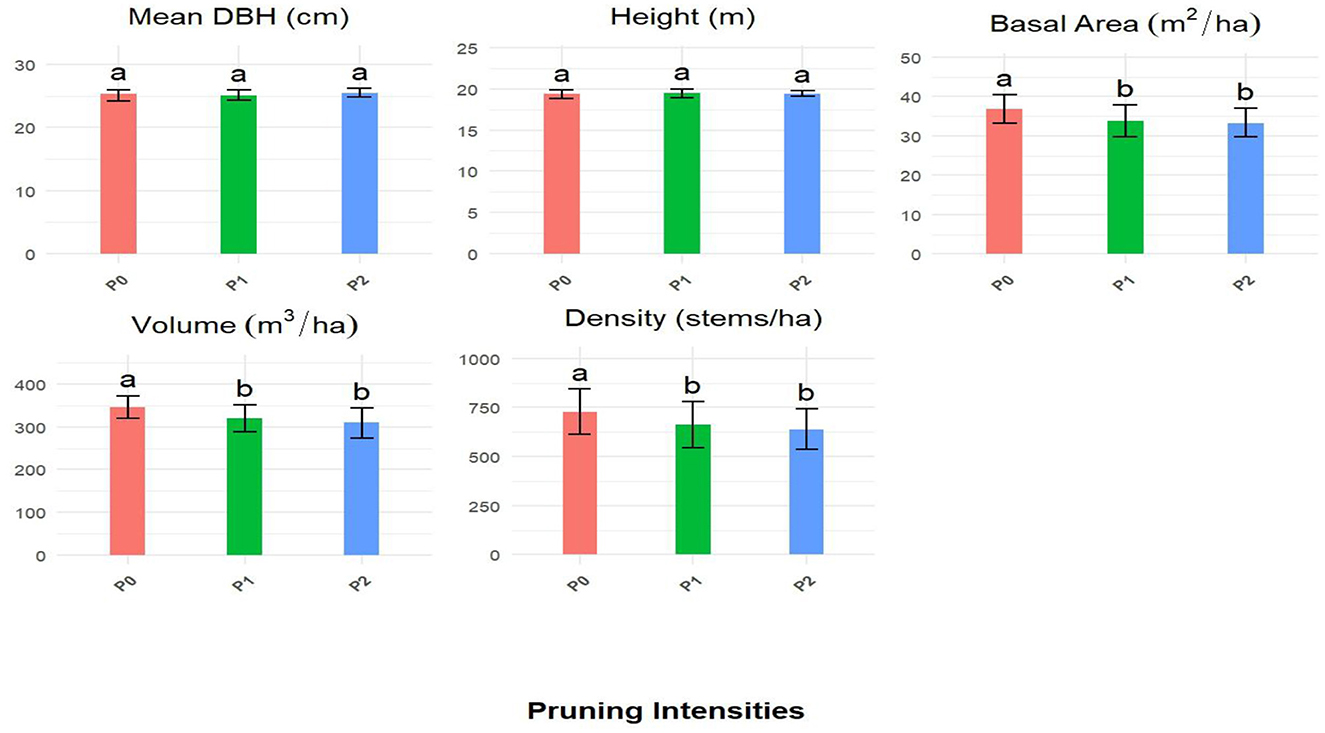
Figure 5. Stand characteristics of Pruning intensities in stands of 50-Year-Age of Larix principis-rupprechtii Mayr plantation. Different letters over bars are significantly different by Tukey HSD post-hoc test (p = 0.05; P0, control pruning; P1, Light pruning; P2, High pruning).
3.4 Effect of topographic variables on tree biometric parameters
Regression analysis revealed a weak negative correlation between mean DBH and elevation, suggesting a slight decrease in DBH with increasing elevation. The relationship between slope and mean DBH also showed a weak negative correlation, though with an extremely low explanatory power. A similar pattern was observed for aspect, indicating that slope and aspect have minimal effects on DBH (Figure 7).
3.5 Influence of thinning intensities on forest structural parameters
DBH showed a significant positive relationship with under-thinning intensities. Similarly, tree height was significantly influenced by EHT and HT thinning intensities, with a notable effect observed in both cases.
Our findings indicate that EHT, HT, and MT thinning intensities significantly influenced basal area and volume, while LT did not significantly affect basal area and volume. Tree density demonstrated significance under various thinning intensities (Supplementary Table S3).
3.6 Influence of thinning intensities on total biomass
Thinning effects on AGB are significant across LT, MT, HT, and EHT intensities, all showing a significant impact. Similarly, thinning intensities significantly affected BGB for all treatments. The most severe adverse effect on total biomass was observed under LT, MT, HT, and EHT treatments. The overall model demonstrated strong explanatory power, reflecting the significant impacts of thinning on biomass metrics (Supplementary Table S4).
3.7 Influence of thinning intensities on total carbon
Reductions in AGC and BGC were observed across all treatment intensities (LT, MT, HT, and EHT), with statistically significant. The model demonstrated strong explanatory power for the variation in AGC and BGC, as indicated by high F-values and R2 values. Additionally, the treatments (LT, MT, HT, and EHT) led to the most substantial reductions in total carbon storage, which were also significant. The variability in total carbon storage was well explained by the model, further reinforcing the observed trends.
SOC exhibited a distinct trend, with the effect of EHT on SOC being less pronounced and not statistically significant. Significant effects on SOC were observed for the LT, MT, and HT intensities. This is further reflected in the model's lower explanatory power for SOC (Supplementary Table S5).
3.8 PCA analysis with silvicultural treatments and their parameters
The Principal Component Analysis (PCA) biplot illustrates that the first two principal components (F1 and F2) effectively summarize the dataset, capturing most of the total variance. F1 is the dominant component, with F2 contributing additional explanatory power. Together, these two components account for over 94% of the variance, highlighting their importance in understanding the data structure. The variable SOC strongly correlates with F1, signifying its major contribution to the variance, while variables like Basal Area, DBH Volume, and Height contribute significantly to F2. Clustered variables such as AGC, Total C, AGB, T. Biomass, BGB, and BGC show positive intercorrelations and primarily influence F1. Treatments such as T2P0 and T1P2, positioned on the positive side of F1, indicate higher values for variables like AGC and AGB, while treatments like T3P1, T3P2, and T4P0, on the negative side, reflect lower values. Samples near the origin, such as T1P1 and T2P0, represent average values for the variables, suggesting no extreme characteristics. This spatial arrangement highlights the relationships between treatments, variables, and sample groups (Figure 8).
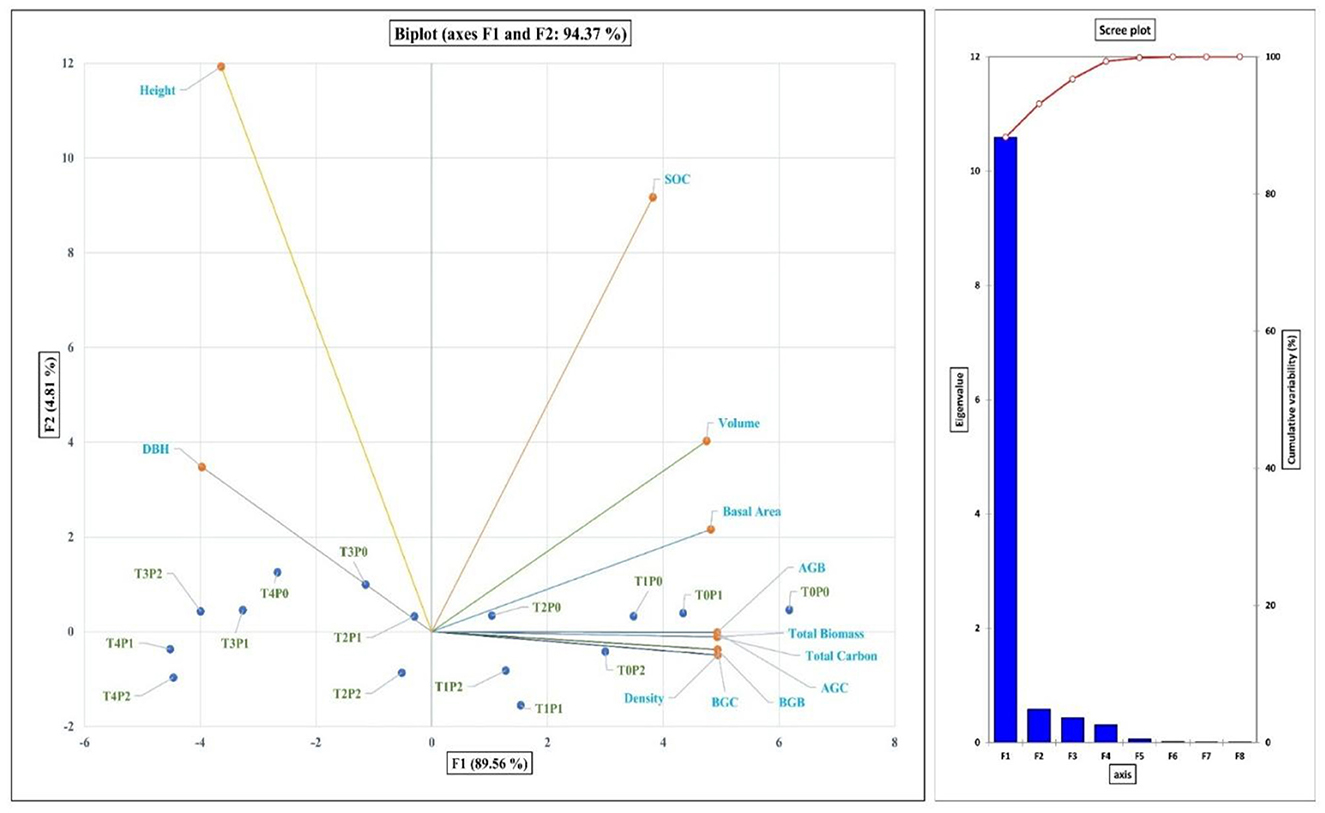
Figure 8. PCA bi-plot representing the ordination of treatment, forest biometric parameters, total biomass, and total carbon (F1–F2). A Scree plot indicating the number of significant principal components.
Table 4 presents the results of the Principal Component Analysis (PCA), highlighting the eigenvalues and explaining the variability and cumulative variance of the six principal components. The first component (F1) is the most dominant, accounting for most of the variance, while the second component (F2) further contributes to the overall variability. F1 and F2 capture over 94% of the total variance, making them the most influential components in understanding the dataset's structure. The remaining components contribute progressively less to the overall variance, with the third and fourth components (F3 and F4) explaining a smaller proportion. The last two components (F5 and F6) offer minimal additional explanatory power.
4 Discussion
The results are consistent with our hypothesis, demonstrating that silvicultural treatments significantly influence biomass and carbon stock in 50-year-old Larix principis-rupprechtii Mayr plantations in northern China. DBH and individual tree height increased under silvicultural treatments. Similarly, reported thinning promotes greater DBH growth than height across various forest ecosystems (Kim et al., 2016). Our findings demonstrate a significant reduction in total biomass and carbon stocks with increasing silvicultural treatment intensity. The most substantial declines were observed in treatments subjected to heavy thinning (HT) and extreme heavy thinning (EHT) compared to the control treatment (T0P0). This suggests that while thinning can reduce competition and potentially enhance the health and growth of remaining trees, it also leads to a marked decrease in the forest's overall biomass and carbon storage capacity.
There is a progressive decline in the AGB of larch with increasing thinning intensity, with the control group (CK) having a higher AGB than the thinned groups. The AGB of the thinned group was 34.4%, representing a 36% reduction compared to the CK group (Meng et al., 2022). Similarly, it found that thinning did not increase net carbon stocks in plantations, while in the case of Scots pine (Pinus sylvestris L.) and Pyrenean oak (Quercus pyrenaica), the impact of thinning intensities on carbon stocks was negligible (Alvarez et al., 2016). In the 50-year loblolly pine rotation, total carbon stock was lower in thinned stands compared to non-thinned stands. These studies collectively reinforce that thinning intensity and species-specific responses critically determine carbon outcomes. However, alternative evidence suggests that moderate thinning can have contrasting effects under specific conditions. For instance, simulation models (Lin et al., 2018). That thinning could stabilize carbon use efficiency and mitigate tree mortality risks under warming climates, potentially offsetting initial biomass losses (Collalti et al., 2018). Further reported that moderate thinning (20%−35% removal) optimized total carbon density by promoting a balance between aboveground biomass gains and improved soil organic carbon. Our results indicated that pruning had a less significant impact on biomass and carbon stocks than thinning. This suggests that pruning influences tree structure and health more significantly than it affects overall forest carbon dynamics (Wang et al., 2024b).
Pruning is a common silvicultural operation that impacts tree health and structure (Clark and Matheny, 2010). Pruning can be one of the best practices for forest management (Grabosky and Gilman, 2007). However, tree growth rates showed no significant response to pruning, understory removal, or their interactions (Li et al., 2020). Our results show that the highest SOC levels were recorded in control plots and decreased with increased management intensity. SOC decreased by 35.6% compared to the control treatment (CT). A study in the Lesser Xing'an Range, Northeast China, found that moderate thinning intensity could enhance soil organic carbon, litter retention, and soil nutrient levels, improving carbon sequestration in degraded forests during spring and summer. Higher thinning intensities led to carbon loss in autumn and winter (Zhang et al., 2024).
That moderate thinning (20%−30%) promoted short-term carbon sequestration, while heavier thinning (41%−50%) initially reduced carbon storage before eventual recovery (Lin et al., 2024). Furthermore, suggested that light thinning could enhance soil carbon content and reduce greenhouse gas emissions, further supporting the role of moderate interventions in sustainable forest management (Dai et al., 2024). That 18% thinning intensity significantly improved carbon storage and growth in Pinus koraiensis plantations (Sakib et al., 2024). A 30% thinning intensity provided the strongest carbon sequestration in natural mixed forests. These findings suggest that moderate interventions could represent a more optimal management approach compared to heavier thinning regimes, which is consistent with the trends observed in our study (Qu et al., 2024). The biomass generated from thinning and pruning treatments in forest management can be used for bioenergy production, such as biofuels or electricity generation. Using this biomass as a substitute for fossil fuels can significantly reduce carbon emissions, contributing to climate change mitigation (Martinez-Valencia et al., 2021). Bioenergy from forest biomass is considered a renewable energy source, and its use helps to balance carbon emissions (Pang et al., 2019). Forest management practices, like thinning, can enhance carbon sequestration and bioenergy production (Ruiz-Peinado et al., 2017). Using forest biomass for energy may present a sustainable alternative to fossil fuel consumption (Wang and Azam, 2024).
This study, which included 45 plots with 15 treatments across five thinning and three pruning intensities, provides valuable details but also has limitations. It was conducted in a specific geographical region (Saihanba, Northern China) under relatively uniform site conditions, which may limit the direct transferability of results to other ecological zones or forest types. Additionally, the study period captured only the mid-term effects (13 years post-treatment), whereas long-term dynamics of biomass recovery and carbon sequestration remain uncertain. Notably, site-specific factors such as soil type, historical land use, or genetic variability of Larix principis-rupprechtii Mayr populations were not explicitly controlled, which could introduce unquantified variability. Future research should extend study periods to assess long-term carbon fluxes and recovery trajectories, incorporate additional environmental gradients (e.g., precipitation, temperature variability), and apply high-precision biometric modeling. Moreover, investigating thinning–pruning interactions with biodiversity outcomes, ecosystem resilience, and microclimatic changes would yield a more holistic understanding of sustainable forest management under changing climatic scenarios.
5 Conclusion
This study investigated the influence of varying thinning and pruning intensities on biomass allocation and carbon stocks in Larix principis-rupprechtii Mayr plantations. The results demonstrate that higher thinning intensities reduce aboveground and belowground biomass, total stand biomass, and soil organic carbon stocks. While thinning promoted individual tree growth, the cumulative carbon gain at the stand level was compromised due to reductions in tree density. Pruning had a lesser impact and primarily affected tree form and structural attributes rather than contributing meaningfully to stand-level carbon storage. Light to moderate thinning, particularly when integrated with light pruning, offers a sustainable compromise supporting forest health without substantially reducing carbon sequestration potential. Intensive thinning, especially in mature stands, risks waning the ecological role of these plantations as carbon sinks. These outcomes emphasize the need to carefully calibrate thinning and pruning regimes within carbon-focused forest management strategies. The findings contribute to the current discourse on forest-based climate mitigation, reinforcing the importance of management intensity in shaping long-term carbon outcomes. Forest planners and policy-makers should consider conservative silvicultural interventions as part of broader strategies to enhance carbon retention while maintaining forest productivity and ecological integrity.
Data availability statement
The original contributions presented in the study are included in the article/Supplementary material, further inquiries can be directed to the corresponding authors.
Author contributions
JA: Conceptualization, Data curation, Formal analysis, Investigation, Methodology, Software, Validation, Visualization, Writing – original draft, Writing – review & editing. WHa: Investigation, Resources, Writing – original draft, Writing – review & editing. KM: Formal analysis, Writing – original draft, Writing – review & editing. BM: Writing – original draft, Writing – review & editing. WHu: Formal analysis, Writing – original draft, Writing – review & editing. KH: Writing – original draft, Writing – review & editing. FS: Writing – original draft, Writing – review & editing. YQ: Supervision, Writing – original draft, Writing – review & editing. JZ: Supervision, Writing – original draft, Writing – review & editing.
Funding
The author(s) declare that financial support was received for the research and/or publication of this article. Technical demonstration of naturalization upgrading and integrated information management of the artificial ecological public welfare forest in Saihanba: Grant Number: 244C7501D.
Acknowledgments
This work was made possible by the support, cooperation, and collaboration of the Saihanba Mechanical Forest Farm staff provided invaluable assistance and expertise throughout the project. Additionally, the Hebei Forest Department members played a crucial role in supporting our efforts. The State Key Laboratory of Efficient Production of Forest Resources, contributed significantly with their advanced research and resources. Furthermore, the Engineering Technology Research Center of Pinus tabuliformis, of National Forestry and Grassland Administration, offered essential technological insights and guidance. Their collective efforts were instrumental in the successful completion of this work.
Conflict of interest
The authors declare that the research was conducted in the absence of any commercial or financial relationships that could be construed as a potential conflict of interest.
Generative AI statement
The author(s) declare that no Gen AI was used in the creation of this manuscript.
Publisher's note
All claims expressed in this article are solely those of the authors and do not necessarily represent those of their affiliated organizations, or those of the publisher, the editors and the reviewers. Any product that may be evaluated in this article, or claim that may be made by its manufacturer, is not guaranteed or endorsed by the publisher.
Supplementary material
The Supplementary Material for this article can be found online at: https://www.frontiersin.org/articles/10.3389/ffgc.2025.1592009/full#supplementary-material
References
Ali, J., Haoran, W., Mehmood, K., Hussain, W., Iftikhar, F., Shahzad, F., et al. (2025). Remote sensing and integration of machine learning algorithms for above-ground biomass estimation in Larix principis-rupprechtii Mayr plantations: a case study using Sentinel-2 and Landsat-9 data in northern China. Front. Environ. Sci. 13:1577298. doi: 10.3389/fenvs.2025.1577298
Ali, J., Malik, S. U., Ashraf, M. I., Zhongkui, J., Husnain, Z., Gulzar, S., et al. (2023). Exploring the potential of carbon sequestration in sub-tropical pine forest ecosystem: a case study in district Kurram, Pakistan. Sarhad J. Agric. 39, 647–654. doi: 10.17582/journal.sja/2023/39.3.647.654
Alvarez, S., Ortiz, C., Díaz-Pinés, E., and Rubio, A. (2016). Influence of tree species composition, thinning intensity and climate change on carbon sequestration in Mediterranean mountain forests: a case study using the CO2Fix model. Mitig. Adapt. Strateg. Glob. Chang. 21, 1045–1058. doi: 10.1007/s11027-014-9565-4
Aye, W. N., Tong, X., and Tun, A. W. (2022). Species diversity, biomass and carbon stock assessment of Kanhlyashay Natural Mangrove Forest. Forests 13:1013. doi: 10.3390/f13071013
Barzagli, F., and Mani, F. (2019). The increased anthropogenic gas emissions in the atmosphere and the rising of the Earth's temperature: are there actions to mitigate the global warming. Substantia 3, 101–111. doi: 10.13128/Substantia-69
Bhatti, U. A., Bhatti, M. A., Tang, H., Syam, M. S., Awwad, E. M., Sharaf, M., et al. (2024). Global production patterns: understanding the relationship between greenhouse gas emissions, agriculture greening and climate variability. Environ. Res. 245:118049. doi: 10.1016/j.envres.2023.118049
Braun, W. J., and Murdoch, D. J. (2021). A First Course in Statistical Programming with R. Cambridge: Cambridge University Press. doi: 10.1017/9781108993456.007
Caurla, S., Bertrand, V., Delacote, P., and Le Cadre, E. (2018). Heat or power: how to increase the use of energy wood at the lowest cost? Energy Econ. 75, 85–103. doi: 10.1016/j.eneco.2018.08.011
Clark, J., and Matheny, N. (2010). The research foundation to tree pruning: a review of the literature. Arboric. Urban For. 36, 110–120. doi: 10.48044/jauf.2010.015
Collalti, A., Trotta, C., Keenan, T. F., Ibrom, A., Bond-Lamberty, B., Grote, R., et al. (2018). Thinning can reduce losses in carbon use efficiency and carbon stocks in managed forests under warmer climate. J. Adv. Model. Earth Syst. 10, 2427–2452. doi: 10.1029/2018MS001275
Daba, D. E., and Soromessa, T. (2019). The accuracy of species-specific allometric equations for estimating aboveground biomass in tropical moist montane forests: case study of Albizia grandibracteata and Trichilia dregeana. Carbon Balance Manag. 14, 1–13. doi: 10.1186/s13021-019-0134-8
Dai, W., Chen, J., Xu, R., Shi, H., Chen, Y., Li, D., et al. (2024). Short-term effects of thinning on vegetation carbon dynamics and soil respiration in secondary broadleaf forests. Forests 15:2109. doi: 10.3390/f15122109
Dar, J. A., Subashree, K., Bhat, N. A., Sundarapandian, S., Xu, M., Saikia, P., et al. (2020). “Role of major forest biomes in climate change mitigation: an eco-biological perspective,” in Socio-economic and Eco-biological Dimensions in Resource use and Conservation: Strategies for Sustainability, eds. N. Roy, S. Roychoudhury, S. Nautiyal, S. K. Agarwal, and S. Baksi (Springer Nature Switzerland AG), 483–526. doi: 10.1007/978-3-030-32463-6_24
de Oliveira, C. P., Ferreira, R. L. C., da Silva, J. A. A., de Lima, R. B., Silva, E. A., da Silva, A. F., et al. (2021). Modeling and spatialization of biomass and carbon stock using lidar metrics in tropical dry forest, Brazil. Forests 12:473. doi: 10.3390/f12040473
Dobner, M., Nicoletti, M. F., and Arce, J. E. (2019). Influence of crown thinning on radial growth pattern of Pinus taeda in southern Brazil. New For. 50, 437–454. doi: 10.1007/s11056-018-9669-x
Dufour, L. (2019). “Tree planting and management in agroforestry,” in Agroforestry for Sustainable Agriculture, eds M. R. Mosquera-Losada and R. Prabhu (Cambridge: Burleigh Dodds Science Publishing), 239–272. doi: 10.19103/AS.2018.0041.14
Eshetu, E. Y., and Hailu, T. A. (2020). Carbon sequestration and elevational gradient: the case of Yegof mountain natural vegetation in North East, Ethiopia, implications for sustainable management. Cogent. Food Agric. 6:1733331. doi: 10.1080/23311932.2020.1733331
Fekadu Hailu, A., Soremessa, T., and Warkineh Dullo, B. (2021). Carbon sequestration and storage value of coffee forest in Southwestern Ethiopia. Carbon Manag. 12, 531–548. doi: 10.1080/17583004.2021.1976676
Feng, X., Wang, Z., Wu, X., Huang, S., Li, J., Lai, C., et al. (2025). Tracking 3D drought events across global river basins: climatology, spatial footprint, and temporal changes. Geophys. Res. Lett. 52:e2024GL111442. doi: 10.1029/2024GL111442
Forrester, D. I., Collopy, J. J., Beadle, C. L., and Baker, T. G. (2013). Effect of thinning, pruning and nitrogen fertiliser application on light interception and light-use efficiency in a young Eucalyptus nitens plantation. For. Ecol. Manage. 288, 21–30. doi: 10.1016/j.foreco.2011.11.024
Ganatsas, P., Tsakaldimi, M., Karydopoulos, T., Papaemannuil, A., and Papadopoulos, S. (2024). Long-term effect of different forest thinning intensity on carbon sequestration rates and potential uses in climate change mitigation actions. Mitig. Adapt. Strateg. Glob. Chang. 29:3. doi: 10.1007/s11027-023-10102-4
Ganesh, K. P., and Pragasan, L. A. (2024). Effects of nitrogen addition on Eucalyptus globulus growth and carbon sequestration potential under various CO2 climatic conditions. Geol. Ecol. Landsc. 8, 185–193. doi: 10.1080/24749508.2022.2109834
Giweta, M. (2020). Role of litter production and its decomposition, and factors affecting the processes in a tropical forest ecosystem: a review. J. Ecol. Environ. 44:11. doi: 10.1186/s41610-020-0151-2
Grabosky, J. C., and Gilman, E. F. (2007). Response of two oak species to reduction pruning cuts. Arboric. Urban For. 33, 360–366. doi: 10.48044/jauf.2007.041
Hao, Z., Le, Q., Song, J., Wang, N., Han, H., Ma, J., et al. (2024). Forest thinning increases surface soil temperature in Larix principis-rupprechtii (Pinaceae) plantations. J. Soils Sediments 24, 793–807. doi: 10.1007/s11368-023-03640-6
He, Q., Zhan, J., Liu, X., Dong, C., Tian, D., Fu, Q., et al. (2025). Multispectral polarimetric bidirectional reflectance research of plant canopy. Opt. Lasers Eng. 184:108688. doi: 10.1016/j.optlaseng.2024.108688
Huang, M. T., and Zhai, P. M. (2021). Achieving Paris Agreement temperature goals requires carbon neutrality by middle century with far-reaching transitions in the whole society. Adv. Clim. Change Res. 12, 281–286. doi: 10.1016/j.accre.2021.03.004
Joshi, R., and Singh, H. (2020). Carbon sequestration potential of disturbed and non-disturbed forest ecosystem: a tool for mitigating climate change. Afr. J. Environ. Sci. Tech. 14, 385–393. doi: 10.5897/AJEST2020.2920
Kaushal, S., and Baishya, R. (2021). Stand structure and species diversity regulate biomass carbon stock under major Central Himalayan forest types of India. Ecol. Process. 10, 1–18. doi: 10.1186/s13717-021-00283-8
Kay, S., Rega, C., Moreno, G., den Herder, M., Palma, J. H. N., Borek, R., et al. (2019). Agroforestry creates carbon sinks whilst enhancing the environment in agricultural landscapes in Europe. Land Use Policy 83, 581–593. doi: 10.1016/j.landusepol.2019.02.025
Ke, S., Zhang, Z., and Wang, Y. (2023). China's forest carbon sinks and mitigation potential from carbon sequestration trading perspective. Ecol. Indic. 148:110054. doi: 10.1016/j.ecolind.2023.110054
Khan, M. N. I., Islam, M. R., Rahman, A., Azad, M. S., Mollick, A. S., Kamruzzaman, M., et al. (2020). Allometric relationships of stand level carbon stocks to basal area, tree height and wood density of nine tree species in Bangladesh. Glob. Ecol. Conserv. 22:e01025. doi: 10.1016/j.gecco.2020.e01025
Kim, M., Lee, W. K., Kim, Y. S., Lim, C. H., Song, C., Park, T., et al. (2016). Impact of thinning intensity on the diameter and height growth of Larix kaempferi stands in central Korea. Forest. Sci. Technol. 12, 77–87. doi: 10.1080/21580103.2015.1075435
Krueger, I., Schulz, C., and Borken, W. (2017). Stocks and dynamics of soil organic carbon and coarse woody debris in three managed and unmanaged temperate forests. Eur. J. For. Res. 136, 123–137. doi: 10.1007/s10342-016-1013-4
Lai, J., Zhu, W., Cui, D., Fan, D., and Mao, L. (2023). The use of R in forestry research. J. Plant Ecol. 16:rtad047. doi: 10.1093/jpe/rtad047
Lewark, S. (2022). “Work in plantation forests,” in Work in Tropical Forests, ed. M. Köhl (Cham: Springer), 141–82. doi: 10.1007/978-3-662-64444-7
Li, F., Shan, Y., Li, M., Guo, Y., and Liu, C. (2024a). Insights for river restoration: the impacts of vegetation canopy length and canopy discontinuity on riverbed evolution. Water Resour. Res. 60:e2023WR036473. doi: 10.1029/2023WR036473
Li, R., Han, J., Guan, X., Chi, Y., Zhang, W., Chen, L., et al. (2020). Crown pruning and understory removal did not change the tree growth rate in a Chinese fir (Cunninghamia lanceolata) plantation. For. Ecol. Manage. 464:118056. doi: 10.1016/j.foreco.2020.118056
Li, Y., Huang, F., Huang, Y., Li, W., and Liu, M. (2024b). Responses of soil organic carbon fractions and stability to forest conversion in the Nanling Nature Reserve, China. Forests 15:1330. doi: 10.3390/f15081330
Li, Y., Li, X., Zhao, M. H., Pang, Z. Y., Wei, J. T., Tigabu, M., et al. (2021). An overview of the practices and management methods for enhancing seed production in conifer plantations for commercial use. Horticulturae 7:252. doi: 10.3390/horticulturae7080252
Lin, J. C., Chiu, C. M., Lin, Y. J., and Liu, W. Y. (2018). Thinning effects on biomass and carbon stock for young Taiwania plantations. Sci. Rep. 8:3070. doi: 10.1038/s41598-018-21510-x
Lin, N., Feng, M., Huang, H., Qiu, Z., Ma, T., Chen, S., et al. (2024). Effects of thinning on carbon storage in a mixed broadleaved plantation in a subtropical area of China. Forests 15:638. doi: 10.3390/f15040638
Long, J. N., Dean, T. J., and Roberts, S. D. (2004). Linkages between silviculture and ecology: examination of several important conceptual models. For. Ecol. Manage. 200, 249–261. doi: 10.1016/j.foreco.2004.07.005
Lu, D., Wang, G. G., Zhang, J., Fang, Y., Zhu, C., Zhu, J., et al. (2018). Converting larch plantations to mixed stands: effects of canopy treatment on the survival and growth of planted seedlings with contrasting shade tolerance. For. Ecol. Manage. 409, 19–28. doi: 10.1016/j.foreco.2017.10.058
Martinez-Valencia, L., Camenzind, D., Wigmosta, M., Garcia-Perez, M., and Wolcott, M. (2021). Biomass supply chain equipment for renewable fuels production: a review. Biomass Bioenergy 148:106054. doi: 10.1016/j.biombioe.2021.106054
Matsushita, M., Nishikawa, H., and Tamura, A. (2022). Effects of girdling intensity, pruning season and thinning on tree growth, crown vigor and wound recovery in Japanese larch. Forests 13:449. doi: 10.3390/f13030449
Mehmood, K., Anees, S. A., Muhammad, S., Albasher, G., Shahzad, F., Hussain, K., et al. (2025). “Spatial and temporal vegetation dynamics from 2000 to 2023 in the Western Himalayan regions,” in Stochastic Environmental Research and Risk Assessment (Springer-Verlag GmbH, part of Springer Nature), 1–22. doi: 10.1007/s00477-025-02971-9
Meng, Y., Zhang, Y., Li, C., Wang, Z., and Li, Y. (2022). The effect of thinning management on the carbon density of the tree layers in larch–birch mixed natural secondary forests of the Greater Khingan Range, northeastern China. Forests 13:1035. doi: 10.3390/f13071035
Murphy, R. (2024). What is undermining climate change mitigation? How fossil-fuelled practices challenge low-carbon transitions. Energy Res. Soc. Sci. 108:103390. doi: 10.1016/j.erss.2023.103390
Nunes, L. J. R., Meireles, C. I. R., Pinto Gomes, C. J., and Almeida Ribeiro, N. M. C. (2020). Forest contribution to climate change mitigation: management oriented to carbon capture and storage. Climate 8:21. doi: 10.3390/cli8020021
Olivier, J. G. J., and Berdowski, J. J. M. (2021). “Global emission sources and sinks,” in The Climate System, eds. J. Berdowski, R. Guicherit, and B. J. Heij (Boca Raton, FL: CRC Press), 33–77. doi: 10.1201/9781003211266-2
Pang, X., Trubins, R., Lekavicius, V., Galinis, A., Mozgeris, G., Kulbokas, G., et al. (2019). Forest bioenergy feedstock in Lithuania – renewable energy goals and the use of forest resources. Energy Strategy Rev. 24, 244–253. doi: 10.1016/j.esr.2019.04.004
Pathak, P., and Reddy, A. S. (2021). Vertical distribution analysis of soil organic carbon and total nitrogen in different land use patterns of an agro-organic farm. Trop. Ecol. 62, 386–397. doi: 10.1007/s42965-021-00164-3
Perea-Moreno, M. A., Samerón-Manzano, E., and Perea-Moreno, A. J. (2019). Biomass as renewable energy: worldwide research trends. Sustainability 11:863. doi: 10.3390/su11030863
Qu, H., Dong, X., Liu, H., Zhang, B., Gao, T., Meng, Y., et al. (2024). Effect of thinning intensity on the carbon sequestration of natural mixed coniferous and broadleaf forests in Xiaoxing'an Mountains, China. J. For. Res. 35:115. doi: 10.1007/s11676-024-01761-3
Ruiz-Peinado, R., Bravo-Oviedo, A., López-Senespleda, E., Bravo-Oviedo, F., and del Río Gaztelurrutia, M. (2017). Forest management and carbon sequestration in the Mediterranean region: a review. For. Syst. 26:10. doi: 10.5424/fs/2017262-11205
Sakib, N., Poudel, T. R., Hao, Y., Roberts, N. J., Iddrisu, A. Q., Adhikari, S., et al. (2024). Effects of different thinning intensities on carbon storage in Pinus koraiensis middle-aged plantations in Northeast China. Forests 15:738. doi: 10.3390/f15050738
Salehi, S., Zare Mehrjerdi, Y., Sadegheih, A., and Hosseini-Nasab, H. (2022). Designing a resilient and sustainable biomass supply chain network through the optimization approach under uncertainty and the disruption. J. Clean. Prod. 359:131741. doi: 10.1016/j.jclepro.2022.131741
Sha, Z., Bai, Y., Li, R., Lan, H., Zhang, X., Li, J., et al. (2022). The global carbon sink potential of terrestrial vegetation can be increased substantially by optimal land management. Commun. Earth Environ. 3:8. doi: 10.1038/s43247-021-00333-1
Sharma, I., and Kakchapati, S. (2018). Linear regression model to identify the factors associated with carbon stock in Chure forest of Nepal. Scientifica 2018:1383482. doi: 10.1155/2018/1383482
Siddiq, Z., Hayyat, M. U., Khan, A. U., Mahmood, R., Shahzad, L., Ghaffar, R., et al. (2021). Models to estimate the above and below ground carbon stocks from a subtropical scrub forest of Pakistan. Glob. Ecol. Conserv. 27:e01539. doi: 10.1016/j.gecco.2021.e01539
Singh, A. N., and Kumar, A. (2022). Comparative soil restoration potential of exotic and native woody plantations on coal mine spoil in a dry tropical environment of India: a case-study. Land Degrad. Dev. 33, 1971–1984. doi: 10.1002/ldr.4286
Singh, S. (2021). “Energy crisis and climate change: global concerns and their solutions,” in Energy: Crises, Challenges and Solutions, eds. P. Singh, S. Singh, G. Kumar, and P. Baweja (Wiley), 1–17. doi: 10.1002/9781119741503.ch1
Suchocka, M., Swoczyna, T., Kosno-Jonczy, J., and Kalaji, H. M. (2021). Impact of heavy pruning on development and photosynthesis of Tilia cordata Mill. trees. PLoS ONE 16:e0256465. doi: 10.1371/journal.pone.0256465
Sun, L. L., Cui, H. J., and Ge, Q. S. (2022). Will China achieve its 2060 carbon neutral commitment from the provincial perspective? Adv. Clim. Change Res. 13, 169–178. doi: 10.1016/j.accre.2022.02.002
Tao, C., Guo, T., Shen, M., and Tang, Y. (2023). Spatio-temporal dynamic of disturbances in planted and natural forests for the Saihanba region of China. Remote Sens. 15:4776. doi: 10.3390/rs15194776
Teron, G., Bordoloi, R., Paul, A., Singha, L. B., and Tripathi, O. P. (2024). Effect of altitude on soil physico-chemical properties and microbial biomass carbon in the Eaglenest Wildlife Sanctuary of Arunachal Pradesh. Geol. Ecol. Landsc. 1–19. doi: 10.1080/24749508.2024.2430040
Ussiri, D. A. N., and Lal, R. (2017). Carbon sequestration for climate change mitigation and adaptation. Cham: Springer. doi: 10.1007/978-3-319-53845-7
Wang, J., and Azam, W. (2024). Natural resource scarcity, fossil fuel energy consumption, and total greenhouse gas emissions in top emitting countries. Geosci. Front. 15:101757. doi: 10.1016/j.gsf.2023.101757
Wang, Z., Li, Y., Wang, G., Zhang, Z., Chen, Y., Liu, X., et al. (2024a). Drivers of spatial structure in thinned forests. For. Ecosyst. 11:100182. doi: 10.1016/j.fecs.2024.100182
Wang, Z., Wang, G., Li, Y., and Zhang, Z. (2024b). Determinants of carbon sequestration in thinned forests. Sci. Total Environ. 951:175540. doi: 10.1016/j.scitotenv.2024.175540
Xu, A., Wang, D., Liu, Q., Zhang, D., Zhang, Z., Huang, X., et al. (2022). Incorporating stand density effects and regression techniques for stem taper modeling of a Larix principis-rupprechtii plantation. Front. Plant Sci. 13:902325. doi: 10.3389/fpls.2022.902325
Yuan, X., Hou, J., Yin, R., and Liu, P. (2023). Assessing the carbon offsetting potential of China's forest sector: reflection and outlook. Carbon Manag. 14:2266671. doi: 10.1080/17583004.2023.2266671
Zhang, B., Gao, R., and Dong, X. (2024). The seasonal impact of thinning intensities on soil carbon cycling in the Lesser Xing'an range, Northeast China. Forests 15:449. doi: 10.3390/f15030449
Zhang, W., Wan, Q., Zhu, G., and Xu, Y. (2023). Distribution of soil organic carbon and carbon sequestration potential of different geomorphic units in Shiyang river basin, China. Environ. Geochem. Health. 45, 4071–4086. doi: 10.1007/s10653-022-01472-w
Zhang, X., Guan, D., Li, W., Sun, D., Jin, C., Yuan, F., et al. (2018). The effects of forest thinning on soil carbon stocks and dynamics: a meta-analysis. For. Ecol. Manage. 429, 36–43. doi: 10.1016/j.foreco.2018.06.027
Zhao, K., Ji, F., Liu, Y., Liu, X., Jia, Z., Ma, L., et al. (2016). Growth of Larix principis-rupprechtii with thinning and pruning. J. Zhejiang A&F Univ. 33, 581–588. doi: 10.11833/j.issn.2095-0756.2016.04.005
Zheng, X., Streimikiene, D., Balezentis, T., Mardani, A., Cavallaro, F., Liao, H. A., et al. (2019). A review of greenhouse gas emission profiles, dynamics, and climate change mitigation efforts across the key climate change players. J. Clean. Prod. 234, 1113–1133. doi: 10.1016/j.jclepro.2019.06.140
Keywords: thinning and pruning intensities, DBH, tree height, basal area, forest management
Citation: Ali J, Haoran W, Mehmood K, Muhammad B, Hussain W, Hussain K, Shahzad F, Qun Y and Zhongkui J (2025) Evaluating biomass and carbon stock responses to thinning and pruning in mature Larix principis-rupprechtii Mayr stands: a case study from Northern China. Front. For. Glob. Change 8:1592009. doi: 10.3389/ffgc.2025.1592009
Received: 11 March 2025; Accepted: 15 May 2025;
Published: 04 June 2025.
Edited by:
Ram P. Sharma, Tribhuvan University, NepalReviewed by:
Prasant Kumar Singh, Government Vijay Bhushan Singh Deo Girls College, IndiaAbhishek Kumar, Indian Council of Agricultural Research (ICAR), India
Copyright © 2025 Ali, Haoran, Mehmood, Muhammad, Hussain, Hussain, Shahzad, Qun and Zhongkui. This is an open-access article distributed under the terms of the Creative Commons Attribution License (CC BY). The use, distribution or reproduction in other forums is permitted, provided the original author(s) and the copyright owner(s) are credited and that the original publication in this journal is cited, in accordance with accepted academic practice. No use, distribution or reproduction is permitted which does not comply with these terms.
*Correspondence: Yin Qun, eWlucXVuMTAwMkBiamZ1LmVkdS5jbg==; Jia Zhongkui, amlhemtAMTYzLmNvbQ==
†These authors have contributed equally to this work
 Jamshid Ali
Jamshid Ali Wang Haoran
Wang Haoran Kaleem Mehmood
Kaleem Mehmood Bilal Muhammad
Bilal Muhammad Wakeel Hussain
Wakeel Hussain Khadim Hussain
Khadim Hussain Fahad Shahzad
Fahad Shahzad Yin Qun
Yin Qun Jia Zhongkui
Jia Zhongkui